Fortifications
Fortifications
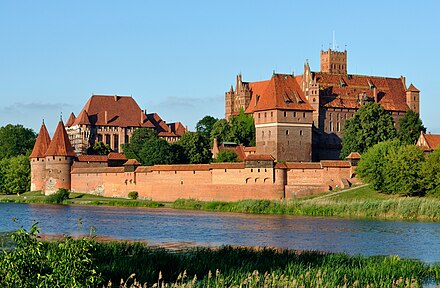
Fortified locations, military constructions, or buildings, have been built from antiquity all the way to the present. At many archaeological sites and in some old towns they are the dominant structures.
Understand
The earliest fortifications, were most likely additions to an already defensible positions afforded by natural topography. Types of fortifications are varied, with new developments continuing all the way to the present. The Romans were also prolific builders of military infrastructure (such as Hadrian's Wall). In Asia, the Great Wall (built to protect a unified China) was commenced in 221 BC.
A hill fort is a natural elevation used as fortress, with less steep sections strengthened by walls, stockades or other structures. They were built by peoples in prehistoric and ancient Europe, such as the Celts and the Old Norse.
A stockade is an enclosure of vertical logs. It is easier to build than a masonry fort, and has been used around the world against lightly armed enemies at least since the Roman Empire; especially in colonial settlements such as the American West.
A city wall was common for ancient and medieval cities; not just for defense, but also for toll collection. As walls became obsolete, many of them were torn down to scavenge the stone, or to make room for new buildings or railroads. While few intact city walls remain, the perimeter is still visible in many cities, as a sharp border between medieval and early modern architecture.
A citadel is a fortification complex which protects a city; usually with many military or civilian buildings on the inside.
Castles are a specific class of fortifications dominant predominantly in Europe, the Middle East and Japan from the 10th century AD, before development of cannons rendered them less defensible.
The bastion fort, also known as star fort, was prevalent in early modern Europe and European colonies from the 15th to 19th centuries, as a platform for cannons, and defense against enemy cannons and firearms.
In the 19th century, cities became larger and cannons became stronger, and bastion forts were replaced by polygonal forts which were partially underground, usually clustered along strategic defense lines outside cities.
The development of high-explosives toward the end of the 19th century, and of aerial warfare and reconnaissance in the early 20th century, saw a shift from surface fortifications, to hardened structures and bunkers below the ground. Many of the military fortifications which have been in use since World War II are also underground works, serving as different kinds of bunkers, command centres and bomb shelters.
Military sites
Not all fortifcations are necessarily open to the traveller (even on an organized tour). It should be especially noted that military facilities (even if seemingly abandoned or out of use) often remain highly sensitive sites, with restrictions for photography, drone flight, and other kinds of intrusion. An unexpected or unannounced visit could at best lead to a lengthy interrogation, with considerably worse outcomes depending ultimately on the mood of the personnel you encounter. You should make formal contact in writing with the relevant military authorities as soon as you have firm travel plans. Do not be disappointed if a planned or agreed visit has to be cancelled or curtailed for operational and security reasons. Or if you are denied access without any reason at all being provided.
Europe
See also: Napoleonic Wars
While the Roman Empire had many river borders (not because rivers were uncrossable, but because patrolling them by boat was easier than patrolling land borders), in places where no river was available, they built walls and fortresses, some of which remained distinctly visible for centuries, with the Germanic Limes and Hadrian's Wall in Northern England perhaps the most notable. However, it was the Middle Ages with its countless mid sized and tiny polities and warfare with heavy focus on relatively small heavy cavalry units and siege warfare that gave rise to many European fortifications still in existence to this day.
Finland
While Finland used not to have the wealth for massive fortifications, there are indeed some. Iron Age hill forts are relatively common, there are castles, not protecting lords but the king's representatives and strategic locations, built under the Swedish Empire such as the great Sveaborg/Suomenlinna fortress from the 18th century, and later the Russian Empire such as the equally grand Bomarsund on Åland (destroyed by the English and French in the Crimean War) and parts of the "Peter the Great" chain of fortifications of the early 20th century. Parts of the Salpa Line from WW2, along the Russian border, also remain, often in off-path locations such as Tankavaara, Savukoski, Virolahti and Miehikkälä, but also near Joensuu. Several 20th-century coastal artillery forts have been opened for visitors.
- Olofsborg (Olavinlinna). The world's northernmost medieval stone fortress still standing, built beginning in 1473 to protect the Kalmar Union border against the Russians (Novgorod). At the turn of century it represented the state of the art as a defensive castle. The interior has been destroyed by fires, two of the original towers are gone and bastions have been added, but otherwise it is well preserved. It now serves as museum, as celebration premises, and each summer as outdoor stage for the internationally recognised Savonlinna Opera Festival.
- Suomenlinna (Sveaborg). Large fortress built in the 18th century. Well preserved, now a park-like suburb and a popular picnic destination, with museums, exhibitions and other activities.
- Bomarsund. Grand fortress built in the 19th century, destroyed by the English-French navy 1854 in the Crimean War. Ruins and exhibitions.
- Örö. Fortress island, with fortifications first built 1910–1915 as part of the "Peter the Great" chain of fortifications defending the Gulf of Finland and thereby Saint Petersburg. The fortress served into the 1990s, now being part of the Archipelago Sea National Park. Military constructions to be seen include a battery with huge 12" artillery pieces, designed to cut off the Gulf of Finland for an invading navy.
France
In part due to a distinct manpower disadvantage caused by lower French birth rates, France built fortifications for both World War II in Europe and World War I. Germany tried to go around the bulk of those in both wars by violating the neutrality of Belgium. While the French plan was partially successful in World War I, the "Maginot Line" as it was called was not able to stop or even delay the rapid advance of German tanks in World War II. While some argue that the purpose always was to force the German army to once more violate Belgian neutrality and invade through the Ardennes (a heavily wooded, hilly terrain, then deemed unsuitable for major offense) the fact of the matter is that France capitulated in a matter of weeks in 1940.
Germany
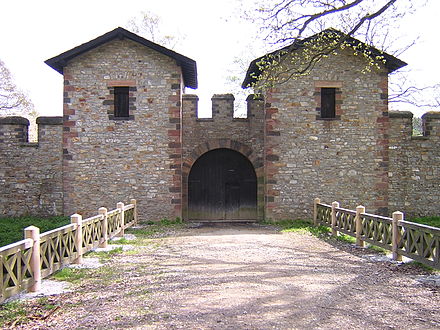 The English term castle has two words with different nuances of meaning in German. A Burg (from which the word "burgher" is derived, a person who can expect protection in a Burg) is mainly a fortification, where any purpose as a residence is secondary, whereas a Schloss is largely a palace; a representative building with little or no military value. However, many a Schloss is made to look like a Burg and even originally military buildings may have taken on non-military purposes later on. Festung is a generic German word for a fortress.
The English term castle has two words with different nuances of meaning in German. A Burg (from which the word "burgher" is derived, a person who can expect protection in a Burg) is mainly a fortification, where any purpose as a residence is secondary, whereas a Schloss is largely a palace; a representative building with little or no military value. However, many a Schloss is made to look like a Burg and even originally military buildings may have taken on non-military purposes later on. Festung is a generic German word for a fortress.
-
Bundesfestung Ulm (Ulm), 48.411944°, 9.982778°. The "Federal Fortress" of the German Confederation (1815-1866) was one of very few installations the loose German Confederation had in common rather than as the property of individual member states. It never saw a shot fired in anger and was primarily intended for a defensive war the German Confederation never fought so it is in unusually good condition today. 2018-06-08
-
Festung Ehrenbreitstein, Koblenz, 50.365°, 7.61528°. This is a big military castle/fort in good condition. From there you have a good view over Koblenz. There is also one of the museum of Koblenz. It is located on the other side of the Rhine. entry fee about €2 2015-04-18
-
Roman Fort Saalburg, Bad Homburg (Take a bus from Bad Homburg, or take the "Taunusbahn" to station "Saalburg" and walk 45 minutes along the Limes to reach the fort.), 50.2715°, 8.56666°. near World Heritage Site Limes (border wall between the Roman Empire and free Germanic lands) 2016-02-05
Russia
Russian cities are known for having a distinctive type of fortress known as the kremlin, of which the one in Moscow is undoubtedly the most famous, and remains the seat of the Russian government to this day. Usually, you can except to see a number of churches within the walls of a kremlin.
Sweden
Sweden has several ancient hill forts (fornborg). Sweden had rather few castles in the Middle Ages; many castles and fortresses were built for the 17th- to 18th-century Swedish Empire. While Sweden has not been at war since 1814, the country has extensive underground bomb shelters built for the World Wars and the Cold War.
- Visby City Wall. A well-preserved limestone city wall, which has earned Visby's old town status as a UNESCO World Heritage Site.
- Vaxholm Fortress (Vaxholms fästning), 59.402827°, 18.359515°. A fortress which has guarded Stockholm's harbour since the 16th century, and famously resisted an attack by the Russian Empire in 1719 (see also Swedish Empire). Over the centuries, an extensive coastal defense system was built across the archipelago, with Vaxholm as its headquarters. The fortress was also used as a prison. Some scenes of a 1970 Pippi Longstocking film was shot here. Since 2003, the fortress is a museum with a restaurant and a hostel.
- Boden fortress: A fortification system from the 19th century
- Beredskapsmuseet (The Military Readiness Museum in Sweden), Djuramossavägen 160 (Helsingborg, Sweden). A museum of Sweden's preparation for the war that never came.
- Femöre Fort (Femörefortet), 58.6490°, 17.1064°. A 1960s coastal fortress with an extensive Cold War museum.
Switzerland
While the Swiss last went to war in 1848 in a civil war mostly between Catholic conservatives and Reformed liberals and Switzerland was last invaded by a foreign power in the Napoleonic Wars, the Swiss had an elaborate and costly defense scheme in place for World War II in case Germany (or any other power) ever violated Swiss neutrality. This "national redoubt" was for a time credited with making invasion seem so costly as to make Germany reconsider; however, these days many historians point out that the Nazis had little to gain from invading Switzerland and neutral Swiss banks were an important factor for the German wartime economy.
United Kingdom
- Whitehorse Hill, Uffington (near Wantage), 51.574602°, -1.571416°. The site of an Iron Age hill fort and Uffington White Horse. The site sits on the ridgeway long distance footpath, which follows the line of a chalk ridge which separates the Berkshire Downs to the south and the vale of the white horse to the north. The horse has been cut into the chalk downs can be seen from miles around. It has been "cleaned" by local communities about every 20 years continuously since it was first made about 2000 to 3000 years ago. The hill fort consists of a large circular bank and ditch 1-1.6km in circumference, with grass all over and inside. There are great views from the site, which is fantastic for pic-nics on a sunny day. Also nearby is the Dragon's Hill which appears to be man made and could somehow be associated to the site. Access is easiest by car - it has two car parks (one of which is nearer the horse and recommended only for visitors requiring easier access) The lower car park includes some signage explaining the Whitehorse, and ridgeway. There are picnic tables near by. One could also easily take in the White Horse and Hill Fort, on a walk along the ridgeway.
Middle East
The Middle East is the cradle of organized warfare with standing armies distinct from the general population and thus also saw some of the earliest sieges we know of. However, many of them are archeological sites or buried between several layers of newer construction. The Trojan War took place in what is now Anatolia and is said to have involved a ten year siege with projection of power across the Aegean Sea over three millennia ago. During the Crusades, "Crusader States" arose in the Levant, establishing a tiny (largely immigrated) Catholic elite in largely Muslim, Jewish or non-Catholic Christian regions and as such the rulers built impressive (and in some cases still extant) fortresses to defend their hard won territories against the inevitable Muslim counterattack.
- Masada, 31.315556°, 35.353889°. The fortress was used in the "Big Jewish War", the first and largest of three uprisings by Jews in the then Roman province Judaea against the Roman Empire. Here the original Zealots (from whom the English word derives) held out after Jerusalem (and the Temple with it) had already fallen, but ultimately the Romans built a giant ramp to conquer the fortress. The sources tell us that the defenders entered into a suicide pact, killing virtually everybody inside, so as to not fall into Roman hands alive. Archeological evidence has largely lent credence to this story. Masada has often been cited as an important Zionist symbol. Israeli soldiers have in the past been sworn in here, and the sentence "Masada mustn't fall a second time" is a Zionist saying indicating that the catastrophe of losing the Jewish homeland mustn't repeat under any circumstances. These days, there is a cable car lift to the top, but it doesn't operate before sunrise, and sunrises at Masada are said to be particularly stunning. 2018-06-08
Turkey
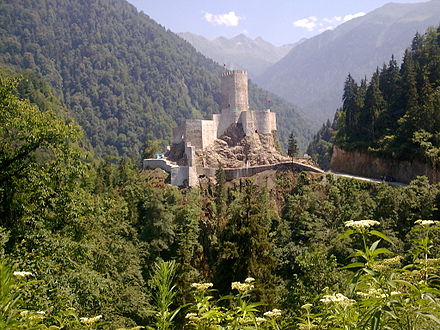 Due to its position along the major routes of the Old World, trampled as many invaders as traders, Turkey is very rich in fortifications, ancient and modern alike. For a start, the Theodosian Walls of Constantinople, impregnable and unbreached until the advent of heavy artillery, are arguably the world's most iconic historic fortification, most of it still standing despite the battle damage from the 1453 Ottoman siege. The banks of the Turkish straits are lined with many other impressive fortresses, often with commanding views of their surroundings—see the Istanbul and Çanakkale articles for full details.
Due to its position along the major routes of the Old World, trampled as many invaders as traders, Turkey is very rich in fortifications, ancient and modern alike. For a start, the Theodosian Walls of Constantinople, impregnable and unbreached until the advent of heavy artillery, are arguably the world's most iconic historic fortification, most of it still standing despite the battle damage from the 1453 Ottoman siege. The banks of the Turkish straits are lined with many other impressive fortresses, often with commanding views of their surroundings—see the Istanbul and Çanakkale articles for full details.
Many towns along the Aegean and Black Sea coasts feature fortresses that started life as trading posts of the Genoese, who controlled trade in the medieval Mediterranean. The lush hillsides and valleys of Eastern Karadeniz, in the far northeast, are dotted by castles that are often likened to those found in fairy tales, while Çukurova (Cilician Plains) in the south of the country is home to a relatively large number of Crusader-era fortresses. The isolated Mediterranean coast to the west is the site of a couple castles that are often considered the most scenic in the country. Further west, Bodrum, Antalya, and Alanya have some of Turkey's most famous and well-visited castles.
North America
Canada
- Fort Calgary, 750 9 Ave SE, Calgary, 51.0453°, -114.046°, +1 403-290-1875. 9AM-5PM daily. Fort Calgary, a Northwest Mounted Police (NWMP, now RCMP) fort was built in 1875 at the confluence of the Bow and Elbow rivers (near modern Inglewood). It became the nucleus around which Calgary grew. The original fort was destroyed decades ago. Today's Fort Calgary is a museum and historic site focusing on the history of the city and of the RCMP. $12/7 (adult/youth)
- Citadelle of Quebec (Citadelle de Québec), 46.8074°, -71.2071°. One of the oldest citadels still in active use. 2019-03-17
- Fort Peninsula (__), Forillon National Park, Gaspé, Quebec (1.2 km [0.7 miles] east of La Penouille via Route 132), 48.852965°, -64.396162°. Quebec's only fully preserved World War II-era shoreline battery, Fort Peninsula was one of the three fixed defences that comprised HMCS Fort Ramsay, a naval base established in 1942 by the Canadian military to defend against Nazi U-Boat attacks, to ensure the safety of merchant vessels passing through the region, and to serve as a refuge for the British Royal Navy in the event that Hitler's forces were to successfully conquer the UK. Nineteen warships based here served a key role in waging the Battle of the St. Lawrence which saw 23 Allied vessels sunk by German subs off Canada's east coast. Today, visitors can walk through the underground corridors of the fortification and observe the vintage gun mortars and other artillery still pointed seaward, and read descriptive panels along the way that explain the strategic military importance of the Gaspé Peninsula during the Second World War. Outside, there's a pleasant seaside picnic area.
United States of America
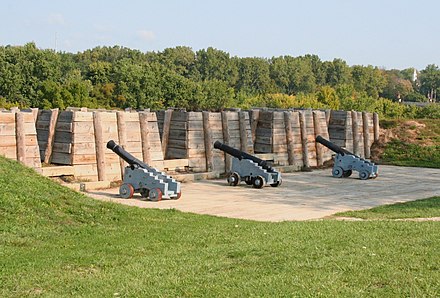
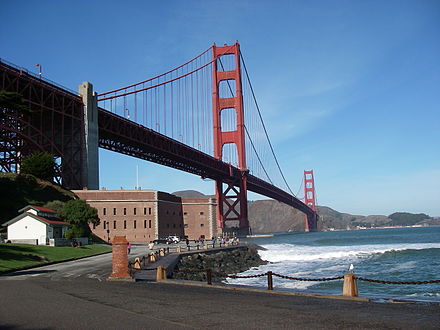
- Castillo de San Marcos, St. Augustine, 29.89795479182392°, -81.31195858542615°. Oldest masonry fort in America, built by the Spanish in the 1600s. 2023-02-20
- Fort Meigs, Perrysburg (Ohio), 41.552778°, -83.651667°. Largest wooden walled fort in North America. Used in the war of 1812. 2019-03-17
- The Alamo, 29.425833°, -98.486111°. An iconic mission and fort, where Davy Crockett, James Bowie, and a number of Texans made their last stand. 2019-02-01
- Fort Elizabeth, 21.951667°, -159.664167°. A strange Russian fort that was built in Hawaii during the 1800's. 2019-03-17
- Fort Point, Golden Gate National Recreation Area. Built in the 1850s, this fort acts somewhat like the Guardian of the Golden Gate Bridge and has historically been an important point for San Francisco's defence. 2022-01-15
South America
Brazil
- Andradas Fort (__), -24.023334°, -46.283957°. Built as a defence for Santos Bay and the nearby port. 2021-09-07
Peru
- Sacsayhuamán, -13.507778°, -71.982222°. A large Inca fortress, mostly made of stonework. 2019-03-17
Uruguay
- Fortaleza General Artigas, -34.888333°, -56.26°. This fort, on the top of the Cerro Hill, houses a collection of armoury. It is the original fort from which Montevideo originated. The fort sits on the top of a hill and can be seen from many places in the city - and you'll have a fantastic view of the city from the fort. Visiting the fort can be hard, as the Cerro district is somewhat of a shantytown and reportedly not safe to wander around in — though it is possible to reach the fort by car or taxi.
Africa
Republic of Congo
- Fort de Shinkakasa, -5.856944°, 13.032778°. A fortification built in the Congo Free State to defend access to the Congo river in 1891. 2021-09-07
South Africa
- Fort Merensky, -25.6975°, 29.410833°. Built in order to protect the mission's convert from attacks by the local Bantu tribes using dry wall construction. 2021-09-07
Asia
China
The Great Wall of China is a series of walls, expanded throughout the long history of Imperial China.
- Diaoyu Fortress (钓鱼城, Diaoyucheng), Hechuan, Chongqing Municipality. One of the best preserved of the more 80 mountain fortresses built during the Song Dynasty to resist the Mongol invaders. The fortress successfully repelled over 200 Mongol attacks before it was overrun in 1279. Möngke Khan was killed here in 1259 during the Siege of Diaoyucheng. 2022-09-18
- Hailongtun Fortress (海龙屯城堡), Zunyi. Hailongtun is a ruined middle age fortress south of Zunyi. Built atop a mountain it has spectacular views and is one of the few examples of middle ages military defenses remaining in China.
- City wall of Nanjing (南京城墙). The city wall of Nanjing was built during the 14th Century, immediately after the Ming Dynasty succeeded the Mongolian Yuan Dynasty. Thanks to preservation and reconstruction works since the 1970s, it is one of the most complete and best preserved city wall in China as of 2022, as other city walls were largely destroyed in previous wars or simply torn down for industrial and urban development. 2022-11-13
India
Main article: Forts and palaces of India
- Red Fort, 28.655833°, 77.240278°. A historic fort that protected the Mughal Dynasty for 200 years. 2019-03-17
Indonesia
- Buton Palace Fortress, Bau-Bau, -5.475062°, 122.601687°. Buton Palace Fortress was built in the 16th century by Sultan Buton III named La Sangaji. 2022-12-05
- Fort Belgica, Banda Neira, -4.526188°, 129.898937°. A 17th-century fort acted as a fortification system for the islands of Banda which was the only place in the world during that period where nutmeg was produced. 2022-12-05
- Fort Tolukko, Ternate, 0.813813°, 127.388188°. A small fortification on the east coast of Ternate. It was one of the colonial forts built to control the trade in clove spices. 2022-12-05
Malaysia
- A Famosa, 2.191617°, 102.250306°. A Portuguese fort that was built in Malacca Malaysia in the 1500's. What little remaining is some of the oldest European architecture in Asia. 2019-03-17
Philippines
- Fort Santiago, 14.595°, 120.969444°. A citadel built by Spanish conquistadors, it played an important role in many moments of Philippines history up to World War II. 2019-03-17
South Korea
- Hwaseong Fortress (Suwon Hwaseong), 37.280733°, 127.010203°. 2019-03-17
- Namhansanseong, 37.478028°, 127.184194°. A mountain fortress. 2019-03-17
Russia
- Por-Bazhyn, Tuva, 50.615°, 97.384722°. Built as an Uyghur palace in the 8th century AD, converted into a Manichaean monastery soon after, abandoned after a short occupation, and finally destroyed by an earthquake and subsequent fire. Its construction methods show that Por-Bazhyn was built within the Tang Chinese architectural tradition. 2021-09-07
- Vladivostok Fortress Museum (__), Batareynaya Ulitsa, 4а, Vladivostok, Primorsky Krai (), 43.122179°, 131.87528°, +7 423 240 08-96. 10:00-18:00. 2021-09-07
Oceania
Australia
- Bare Island Fort, Bare Island Rd, La Perouse, -33.99175°, 151.23152°. 7AM-7PM. The fortified Bare Island is linked by a footbridge. Containing former fortification facilities, Bare Island was a war veterans' home and museum, and is now a historic site that is significant as an almost completely intact example of late 19th-century coastal defence technology. This fort was also used to film Mission Impossible II. 2021-04-05
- Bradleys Head Fortification Complex (Bradleys Head Forts), -33.8523°, 151.246°. A heritage-listed former mast and defensive battery and military fortification and now war memorial and recreational area. The 1840 fort was cut into the sandstone bedrock outcrop on the tip of the headland and included a barbette gun pit at the eastern end and the small circular bastion at the eastern end of the fort is from 1854. 2021-06-11
- Fort Denison (Muddawahnyuh), -33.854968°, 151.225652°. 9AM-5PM. Once a defence facility, then under attack from US friendly fire in World War II, now a popular tourist spot in the iconic Sydney Harbour. If you want to take a tour of the island and visit the tower, you need to purchase a ticket which includes the ferry transport 24 hours in advance from the Sydney Visitors Centre at Cadmans Cottage in The Rocks. The National Parks and Wildlife Service run a half-hour guided tour for $27/$17 and $72 for a 4 person family. That includes the ferry trip to the island. Standby tickets are available for the tours from the cafe on the island for $10, but these are subject to availability. 2021-05-29
- Fort Lytton, -27.4104°, 153.1514°. A heritage-listed 19th century coastal fort in Lytton, built in 1880-1882, and operated until 1965, now in Fort Lytton National Park. 2021-07-26
- Fort Queenscliff, -38.2667°, 144.65°. A historic fort built in the 1860's and used in various capacities to the present day. Due to its strategic location and telegraph connection, this fort fired some of the first Allied shots in both World Wars. 2019-03-25
- Georges Head Battery (Georges Head Military Fortifications), Chowder Bay Rd, Mosman (Parking available in Chowder Bay), -33.8372°, 151.259899°. 24/7. The site consists of the original battery and barracks, designed by Colonial Architect James Barnet, located at the end of Suakin Drive, Georges Heights, two later batteries located adjacent to the corner of Middle Head Road and Best Avenue, Georges Heights, and the Beehive (or Lower) Casemate adjacent to the Armoured (or Upper) Casemate in Chowder Bay Road. The Georges Head Battery is one of three forts in the area that were built for the purpose of defending the outer harbour. 2021-05-30
- Green Hill Fort, 18 Aubrey Parade, Thursday Island, -10.583948°, 142.21138°. Built as part of a preventative measure from a Russian invasion. 2021-09-07
- North Fort, N Head Scenic Dr, Manly, -33.817471°, 151.29667°. 07:00-18:00. 2021-07-26
- Outer Middle Head Forts, Old Fort Road, Mosman, -33.827173°, 151.268214°. 6AM-8PM. 2021-05-30
- Signal Hill Battery (Signal Hill Fort), -33.8495°, 151.2872°. Signal Hill Battery was one of a set of three coastal defence fortifications and were the last link in Sydney's outer defence perimeter, which was intended to defend Sydney from bombardment by an enemy vessel standing off the coast. 2021-06-12
New Caledonia (Fr.)
- Fort Teremba, -21.729194°, 165.71358°. 09:00-16:00. Former jail and headquarters of the French army overlooking the sea. 2021-08-04
New Zealand
- One Tree Hill. One of the largest Māori pā forts, and one of the larger earthworks in general. 2019-03-17
Papua New Guines
- Fort Nub (John's Gully), -9.434204°, 147.1943°. 2021-08-04
See also
- Castles - Medieval
- Grand and Great houses - chateux, stately home, manor house, Schloß, Resedenz, palace
- Military tourism

